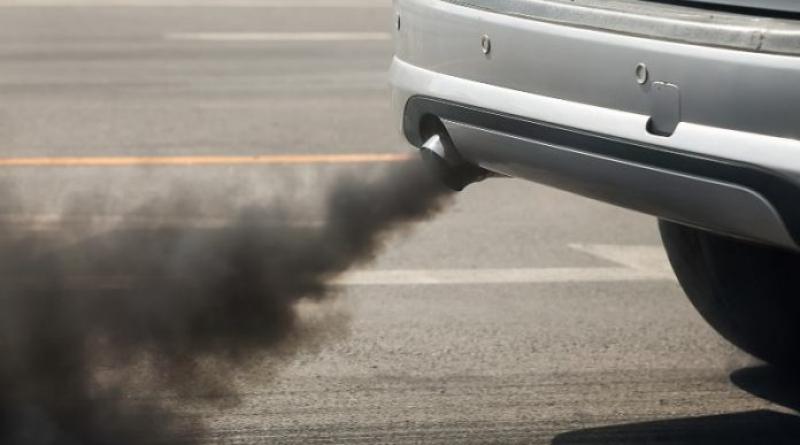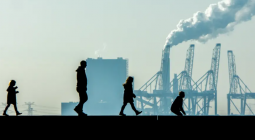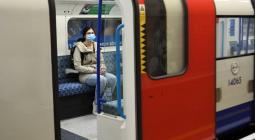The transport sector is the key to cutting ties with fossil fuels

There’s never been a better time to reduce reliance on fossil fuels. Oil and gas prices are skyrocketing as a result of Russia’s invasion of Ukraine, with gas prices exceeding $4 a gallon in the United States in March 2022 and more than $10 a gallon in other countries.
Meanwhile, the world is already experiencing the deadly effects of climate change in the form of heatwaves, droughts and wildfires — impacts that will only intensify as emissions and temperatures rise. As the largest consumer of oil worldwide and one of the main CO2 emitters, reimagining the transport sector is key to cutting ties with fossil fuels.
Reducing oil and gas use in transportation
A growing body of research shows that cutting fossil fuel use by investing in cleaner modes of transport — including public transportation, cycling and walking — is essential for creating safe and sustainable cities.
The International Energy Agency (IEA) recently put forward a 10-point plan for how governments can reduce oil reliance in transport, which includes incentivising public transport use and improving the experience of walking and cycling. According to the TUMI Transport Outlook, public transport capacity needs to double and 50% of trips should be made by walking or cycling by 2030 to limit global temperature rise to 1.5oC (2.7oF), the target scientists say is necessary for preventing the worst effects of climate change.
The 2022 IPCC mitigation report found that cities can reduce their transport-related fuel consumption by about a quarter through combinations of more compact land use and car-free infrastructure, like pedestrian lanes and bike pathways. And other research shows that investing in the public transport sector and walking and cycling infrastructure yields myriad benefits for the climate, economy and human health.
And yet, despite the very clear benefits of public transport, walking and cycling, they remain grossly underfunded compared to infrastructure for cars. Here are five ways to boost public transport and active mobility to reduce oil reliance and create a more sustainable future:
1) Keep motorisation growth rates in check
The world is on pace to go from 1.3 billion cars today to 2.2 billion by 2050. Even with the rising numbers of electric vehicles, reducing the rate of motorisation remains one of the main ways to reduce transportation-related oil use and carbon emissions. It is also the most challenging to address, as it requires individual behaviour changes and a break in the decades-old motorisation dependence and prioritisation by individuals, businesses and governments.
Today’s high gas prices can actually help with this behaviour change due to the income elasticity of demand. An example from California shows that for every $0.50 increase in the price per gallon of gasoline, the amount of weekday traffic on freeways next to commuter rail systems declined by 0.7%. Meanwhile, the increase in passengers per day on the nearby commuter rail was approximately equal to the decline in the number of vehicles on freeways.
In lower-income countries where motorisation rates are already low, now is a critical moment to make sustainable modes of transit safer, more efficient and more appealing. In cities like Addis Ababa and Bogotá, 80-90% of all trips are made via mass transportation, walking or cycling. Car ownership, however, is expected to increase as these countries’ economies grow, and much transportation investment still goes to motor-vehicle infrastructures like roads, highways, bridges and tunnels.
But there’s a way to break with past patterns: When operators improve the quality of mass transportation; provide affordable, safe and comfortable service; and build safe, inclusive and effective walking and cycling infrastructure, they can achieve the behavioural change needed by giving users viable alternatives to cars. For example, beginning in the 1970s, Curitiba, Brazil, implemented a number of land use and transportation strategies, such as installing a bus rapid transit corridor and pedestrianising the city centre. As a result, more than 70% of all travel in the city happens via public transit, walking and cycling.
2) Encourage innovation to improve the quality of mass transport
Mass transport has the potential to significantly reduce oil use and emissions from the transport sector while providing wider and more equal access to jobs, education and services. However, riders are only likely to shift from cars to public transport when services are affordable, high-quality and reliable. High fares and infrequent or uncomfortable service can push many riders towards cars and leave others struggling to access transportation at all.
Yet public transport has been a victim of disinvestment and unsupportive policies for years. For example, according to the National Association of Urban Transport Companies, ridership on Brazil’s public bus systems decreased by more than 26% between 2013 and 2019, in part because of policies promoting car and motorcycle purchases, such as subsidies and tax breaks on fuel costs and import fees. Today, challenges are multiplying in the wake of COVID-19 lockdowns, with ridership plummeting to 20% of pre-pandemic levels in many places.
Providing more space in cities for public transport, increasing finance and investing in new, cleaner, more comfortable infrastructure can make a huge difference in attracting new riders and regaining old ones. In the late 1990s, for example, Bogotá’s public bus system suffered from low operating speeds and high crash and pollution rates. Starting with the establishment of the public transit agency TransMilenio in 1999, the city upgraded the lagging system by serving wider sections of the city, introducing an automated fare system and adding routes and 1,500 new buses. The overhaul increased ridership to up to 1.5 million passenger trips daily; reduced road traffic injuries and deaths in areas where the system operates by 75% and 92%, respectively; and decreased citywide air pollutants by 40%.
Electrification of the sector promises even larger reductions in pollution and potential cost savings via lower fuel expenses. TransMilenio is on track to operate the largest fleet of electric buses outside of China. When completed, the system is expected to include 406 buses and transport 36 million passengers yearly.
3) Creatively finance public transport systems
Experience shows that extensive public transport systems can rarely be paid for by ticket fares alone. Systems need more robust and sustainable funding from the public sector and capital investments — funding that helps mass transport systems not only survive, but thrive.
Diversifying funding sources for hte transport sector can provide steadier revenue that is resilient in the face of crises. The public sector’s financial resources for TransMilenio came from a fuel tax (46%), local revenues (28%), a credit from the World Bank (6%) and grants from the national government (20%). Half of the 25% gasoline tax levied in Bogotá is used for the continued expansion of the system. In Vienna, Austria, which is also expanding its public transport system, user fares cover only about 55% of operating costs, while indirect payments from the national government, a public transport tax on large employers and fees from on-street parking and city-owned parking garages cover the rest.
4) Build safe infrastructure for walking and cycling
Mass transportation is key to making cities work, but walking and cycling are in fact the greenest modes of transport. They are also the easiest and least costly investments in the transport sector.
The active mobility sector has tremendous untapped potential, given that 35% of most urban trips are 5 kilometres (3 miles) or less and 50% of all trips are 10 kilometres (6 miles) or less. But in most places, active mobility is not the leading mode of transport.
Part of the reason is that pedestrians and cyclists face the highest risks of physical harm on the road. Almost 50% of road traffic deaths occur among motorcyclists, pedestrians and cyclists. In low-income countries, pedestrian deaths account for over 40% of traffic fatalities. Women, children and elders disproportionately suffer the consequences.
Walking and cycling are the low-hanging fruit in shifting away from oil reliance. Creating safe infrastructure for active mobility — like permanent, well-designed bike lanes — can protect users and attract new ones, including a broader cross-section of society.
Cities should focus on lowering speed limits for cars and introducing physical separations between walkers/cyclists and motorists, especially where speed limits are above 30 km/hr. These separations can be integrated into the road — such as planters, on-street parking or concrete barriers — or by placing bike infrastructure on a different level than the road.
Bike and pedestrian infrastructure should also connect key locations and transit stations, especially in lower-income areas. For example, the city of Zapopan, Mexico proposed three bicycle lanes to connect Zapopan with Guadalajara, the centre of the metropolitan area. The 15km of new, dedicated bike lanes aimed to provide affordable and safe options for commuters. The first of these lanes was completed in July 2020; initial data shows a 26% increase in cycling commutes via this route.
Many cities can build on progress made during the COVID-19 pandemic. Cycling increased by 200% in the UK during lockdowns in 2020, while 500,000 electric bicycles were sold in the US the same year, more than any other electric vehicle. Hundreds of cities have pedestrianised their streets, reduced speed limits for vehicles, and added pop-up bike lanes. For example, Paris lowered its driving speed limits to 30km/h and added 50km of pop-up bike lanes, which boosted the number of cyclists. The city plans to install another 180km of permanent bike lanes by 2026.
5) Prioritise walking and cycling in transport sector infrastructure budgets
Walking and cycling are often overlooked in infrastructure financing. Budgets typically prioritize car-centric projects, while walking and cycling remain on the sidelines. Governments, as well as multilateral development banks, should realise the importance of financing infrastructure to achieve the required level of safety for pedestrians.
For example, in Peru, the government passed an emergency decree to approve $5.5m for the construction of pop-up bike lanes. As a result, 25 mid- and small-sized cities were selected to build about 400km of cycle lanes. The funding led to critical changes on the road in places where cycle lanes and cycling culture simply did not exist prior to the investment.
Permanently cutting transport’s ties to fossil fuels
The energy implications of the Russia-Ukraine war illustrate the many costs of oil reliance. Limiting global temperature rise to 1.5oC is impossible without a transformative change in transportation, especially urban transportation. Investing in mass transport, walking and cycling should be on the agenda of every government — not only because they are the cleanest, most affordable and most inclusive modes of transport, but because they bring added benefits like reduced traffic congestion and noise, cleaner air, healthier and more active citizens, and much more.
Active mobility and mass transport can enhance the quality of life by helping turn cities into more livable, more equitable places. All governments and other transportation stakeholders should set two very achievable goals: Increase mass transportation ridership and ensure 50% of all trips are made by walking or cycling by 2030.
Image credit: toa55@123rf.com





